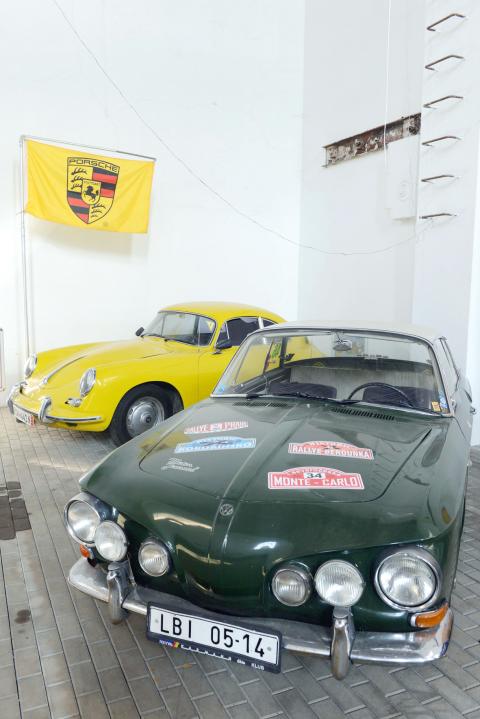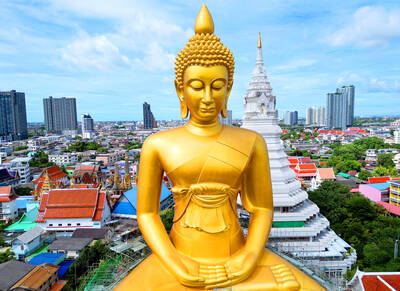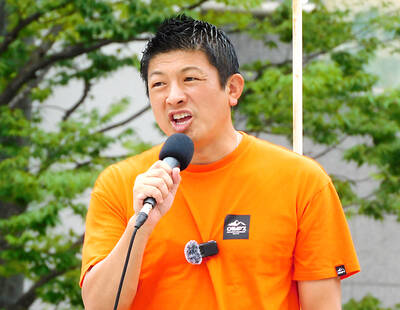The name Porsche has long made sports car enthusiasts swoon, but the Nazi past of the famous brand’s founder has left his Czech hometown sorely divided over his legacy.
In 2010, Vratislavice opened an ultra-modern, million-dollar memorial to Ferdinand Porsche, who invented the Volkswagen Beetle — among the world’s top-selling cars — and in 1898, the first gasoline-electric hybrid.
The German-headquartered Porsche AG loaned cars to the facility, right next to town hall, to help show off their founder’s engineering genius.

Photo: AFP
Meanwhile, town officials put up signs reading “welcome to Vratislavice, the birthplace of Ferdinand Porsche.”
However, not all in this modest locality of nearly 8,000 residents northeast of the capital, Prague, felt comfortable trumpeting their native son.
Last year, a new team voted into city hall could no longer ignore growing protests that Vratislavice — in an area annexed by Nazi Germany in the late 1930s — was “memorializing” a man who had worked for Adolf Hitler.
Anti-Nazi war veterans and the Jewish community objected to the facility never mentioning Porsche’s Nazi connections, Vratislavice Mayor Ales Preisler said.
They condemned Porsche for joining the Nazi SS paramilitary group before the war, and deplored that prisoners of war were used as slave labor at the Volkswagen car plant in Wolfsburg, Germany, when Porsche was general manager.
To calm matters, the town hall late last year renamed the memorial an “exhibition” and added a text saying Porsche had been a Nazi.
Porsche AG took back its cars, but would not talk about the controversy, saying it was a “local issue.”
“All vehicles in our collection are rotated on a regular basis,” was the only explanation given by Porsche AG spokesman Dieter Landenberger, who declined further comment.
The facility has been empty ever since.
About the same time, the town hall removed the signs proclaiming Vratislavice was Porsche’s birthplace.
“These things should not be financed using municipal cash,” Preisler said, adding that Porsche “was a Nazi all right.”
Porsche was born in 1875 into the predominantly ethnic German community in Vratislavice, when it was known as Maffersdorf and part of the Habsburg’s Austro-Hungarian empire. He left at age 18, moving first to Vienna, then later to Germany.
His talent in designing cutting-edge engines and cars saw him climb company ranks at renowned auto makers including Austro-Daimler and Mercedes.
When Hitler took power in Germany in 1933, he was quick to ask Porsche to design a “people’s car,” the predecessor of the VW Beetle.
“Porsche was an active Nazi who was on very good terms with Hitler and used this relationship to push his projects,” said Jan Vajskebr, a historian at the Czech Terezin Memorial located in a World War II ghetto and prison.
The Nazis set up the site, often known by its German name, Theresienstadt, from where tens of thousands of Jews were sent to Auschwitz to their deaths.
Encouraged by Hitler, Porsche gave up his Czechoslovakian citizenship in 1935, four years before his country was occupied by Nazi Germany.
“He didn’t hesitate three seconds,” Preisler said.
The engineer spent 22 months in prison after the war and died in 1951, leaving the business to his son, Ferry, who in turn gained fame with models like the iconic Porsche 911.
Four years after Porsche’s death, the millionth Beetle rolled off the production line. In all, about 23 million Bugs have been built, making the model one of the best-selling cars of all time.
Back “home,” the car maker’s achievements do not always outweigh his past. Petr Jirasko is among those demanding the exhibition disclose all about Porsche’s collaboration with Hitler.
“He was a Nazi. History books don’t lie,” Jirasko said.
However, pulling a cart past the local cemetery where Porsche’s parents are buried, pensioner Miloslav Spidlen disagreed.
“Porsche was a man who achieved something that every driver can appreciate. I value such people, no matter what they’re like,” he said.
Despite the controversy, car collector Milan Bumba is setting up his own private Porsche museum at a local brewery, where he already has three Porsches, a 1956 Beetle and a Porsche tractor.
“Porsche had no choice,” the 54-year-old bus driver said.
“Hitler chose him and if Porsche had refused, he would have ended up in a concentration camp and never achieved anything,” Bumba added.
Bumba believes Porsche “was only interested in designing cars and I think he didn’t see what was happening around him.”
Using his own cash — and some of his wife’s — for his museum, Bumba has already welcomed VW and Porsche fans from Europe, the US, and as far afield as New Zealand and Australia, who came to see the engineer’s birthplace.
He is particularly fond of his old reliable 1956 Beetle, which he drove across Europe and to the Arctic Circle.
“You can fix it with a screwdriver and pliers,” he said.

The military is to begin conscripting civilians next year, Cambodian Prime Minister Hun Manet said yesterday, citing rising tensions with Thailand as the reason for activating a long-dormant mandatory enlistment law. The Cambodian parliament in 2006 approved a law that would require all Cambodians aged 18 to 30 to serve in the military for 18 months, although it has never been enforced. Relations with Thailand have been tense since May, when a long-standing territorial dispute boiled over into cross-border clashes, killing one Cambodian soldier. “This episode of confrontation is a lesson for us and is an opportunity for us to review, assess and

The United States Federal Communications Commission said on Wednesday it plans to adopt rules to bar companies from connecting undersea submarine communication cables to the US that include Chinese technology or equipment. “We have seen submarine cable infrastructure threatened in recent years by foreign adversaries, like China,” FCC Chair Brendan Carr said in a statement. “We are therefore taking action here to guard our submarine cables against foreign adversary ownership, and access as well as cyber and physical threats.” The United States has for years expressed concerns about China’s role in handling network traffic and the potential for espionage. The U.S. has

IDENTITY: A sex extortion scandal involving Thai monks has deeply shaken public trust in the clergy, with 11 monks implicated in financial misconduct Reverence for the saffron-robed Buddhist monkhood is deeply woven into Thai society, but a sex extortion scandal has besmirched the clergy and left the devout questioning their faith. Thai police this week arrested a woman accused of bedding at least 11 monks in breach of their vows of celibacy, before blackmailing them with thousands of secretly taken photos of their trysts. The monks are said to have paid nearly US$12 million, funneled out of their monasteries, funded by donations from laypeople hoping to increase their merit and prospects for reincarnation. The scandal provoked outrage over hypocrisy in the monkhood, concern that their status

A disillusioned Japanese electorate feeling the economic pinch goes to the polls today, as a right-wing party promoting a “Japanese first” agenda gains popularity, with fears over foreigners becoming a major election issue. Birthed on YouTube during the COVID-19 pandemic, spreading conspiracy theories about vaccinations and a cabal of global elites, the Sanseito Party has widened its appeal ahead of today’s upper house vote — railing against immigration and dragging rhetoric that was once confined to Japan’s political fringes into the mainstream. Polls show the party might only secure 10 to 15 of the 125 seats up for grabs, but it is